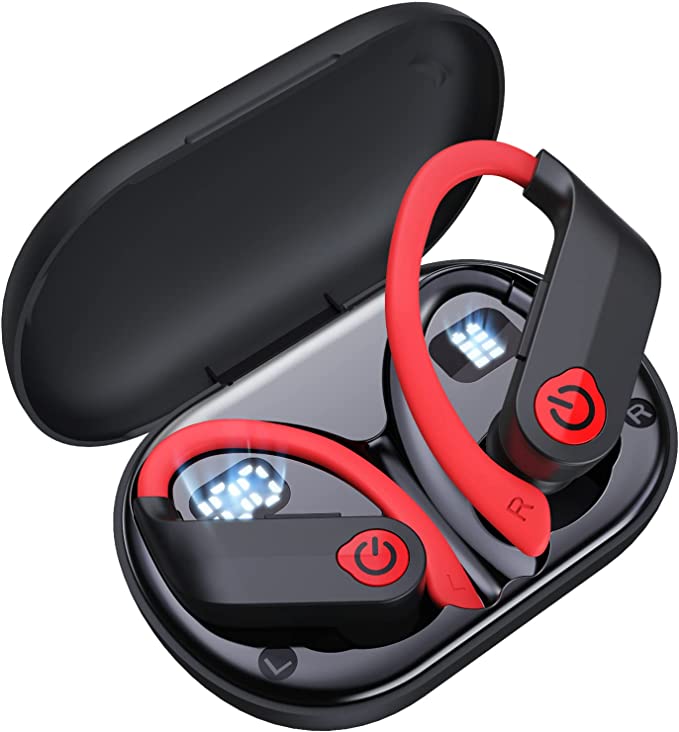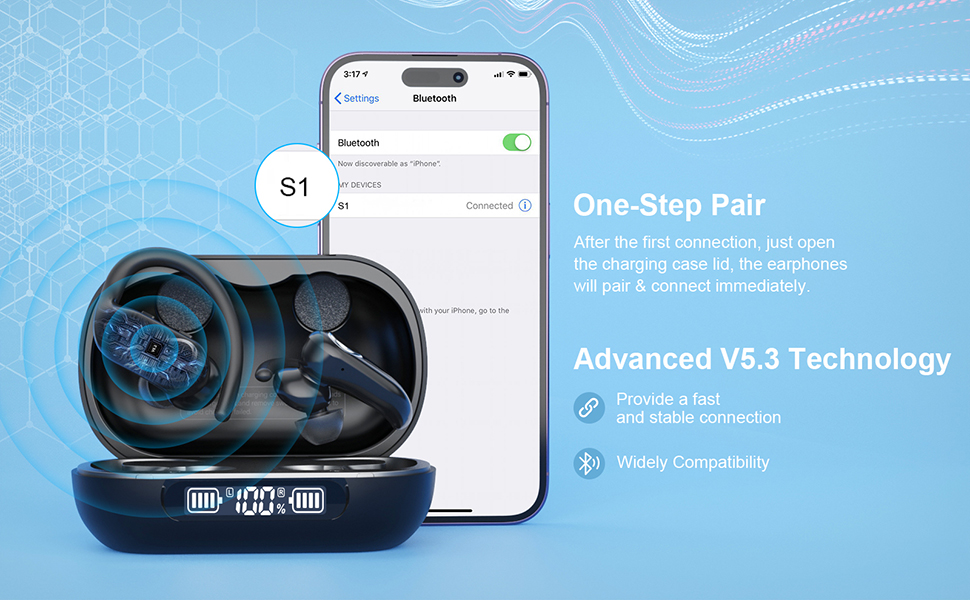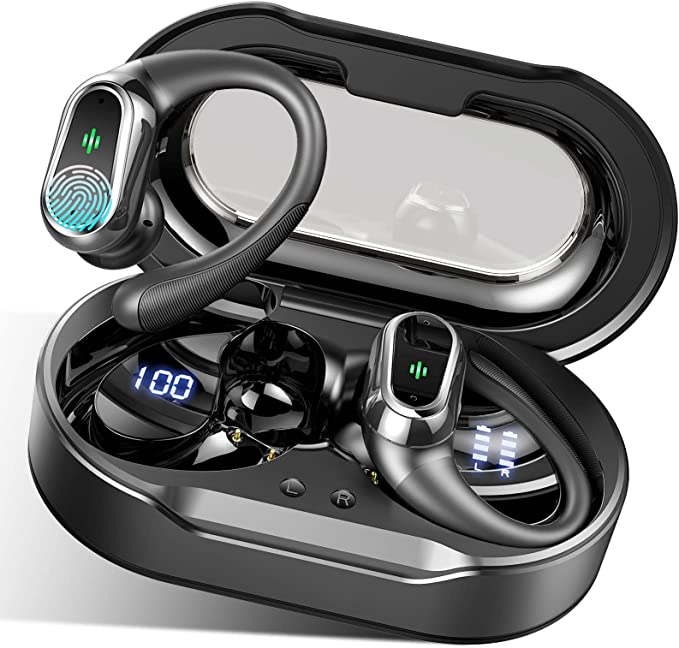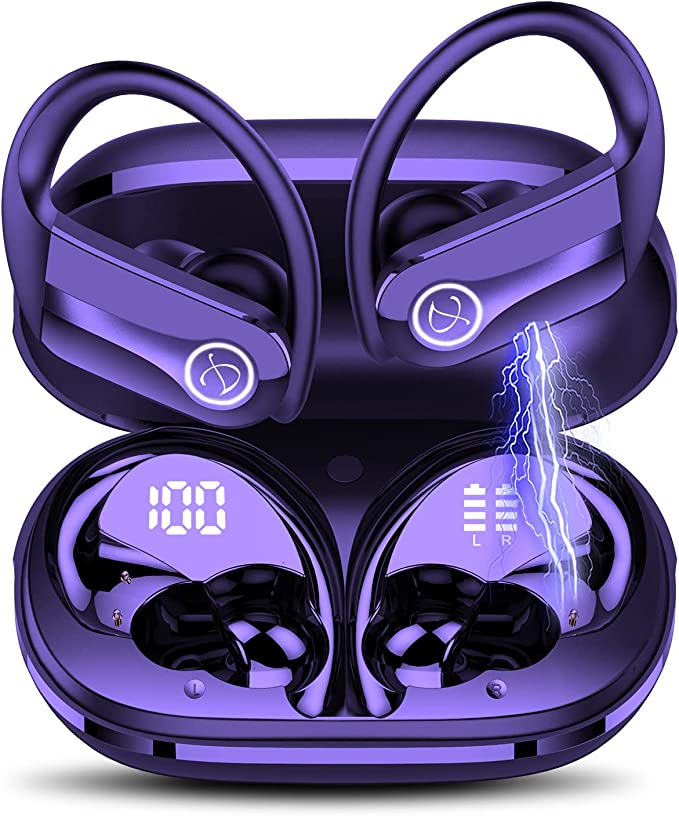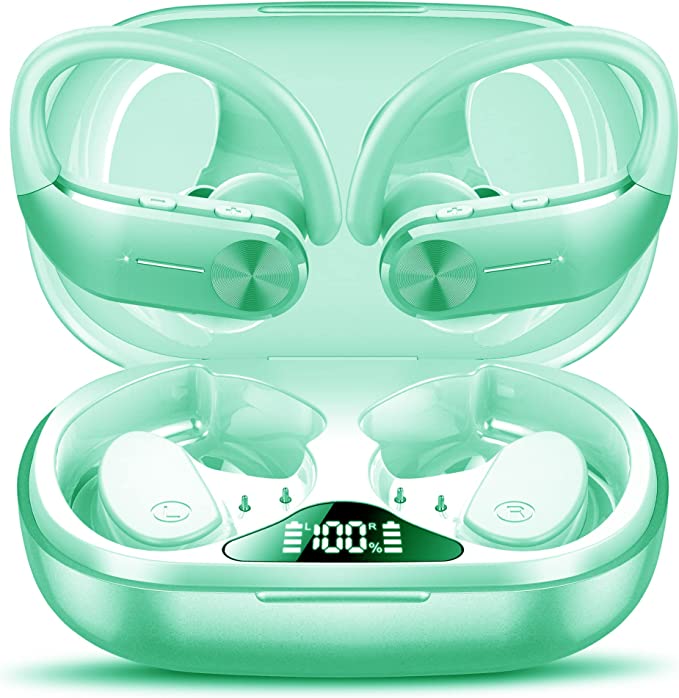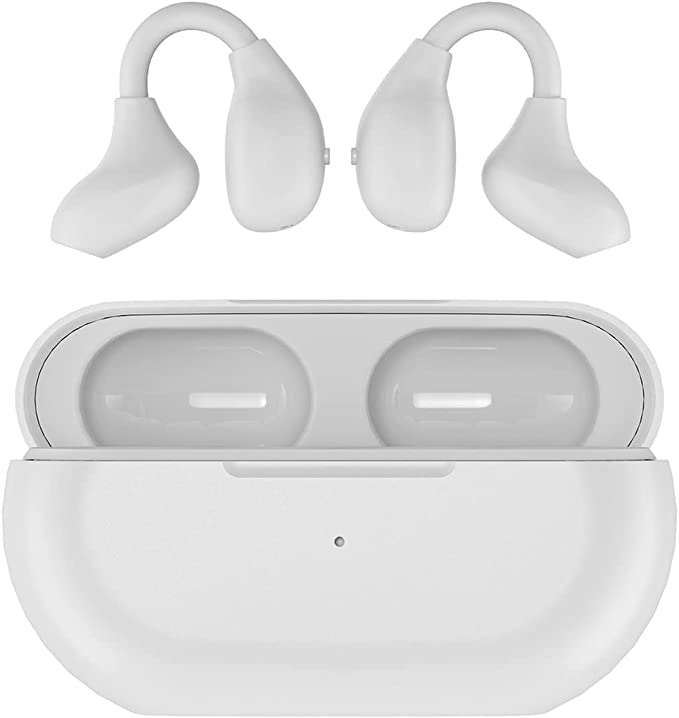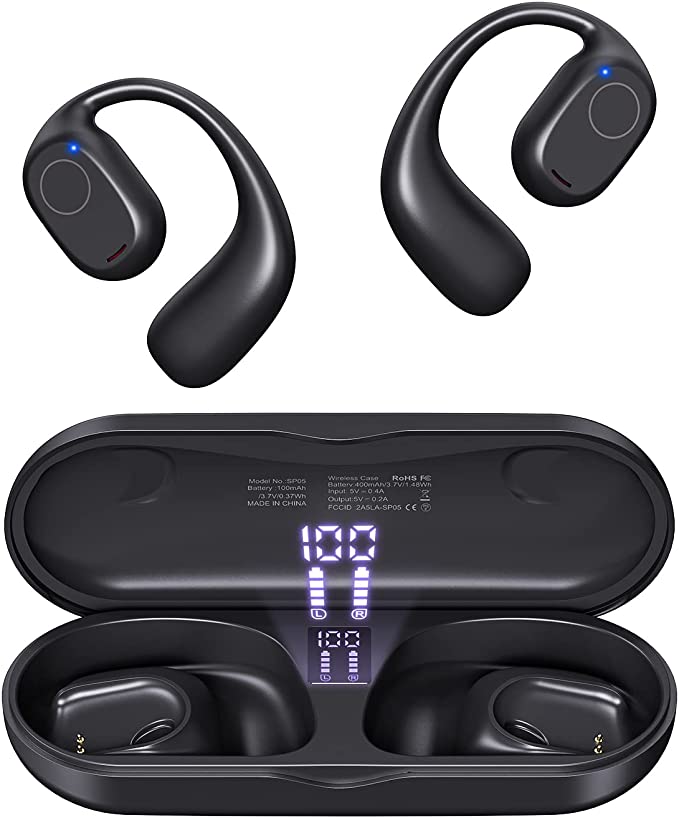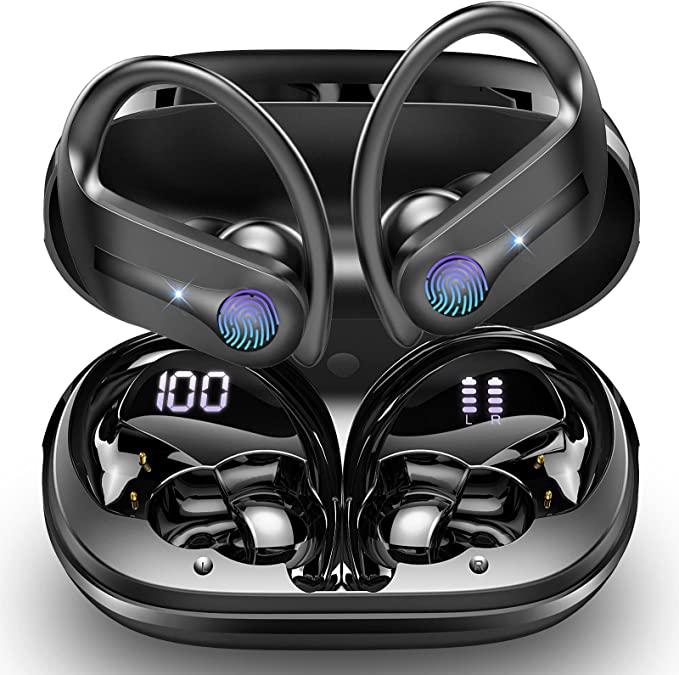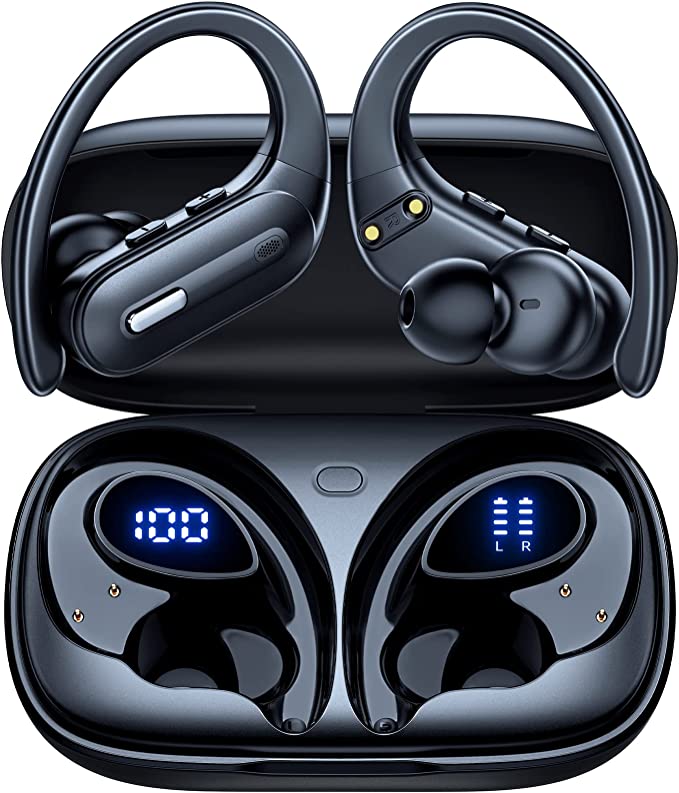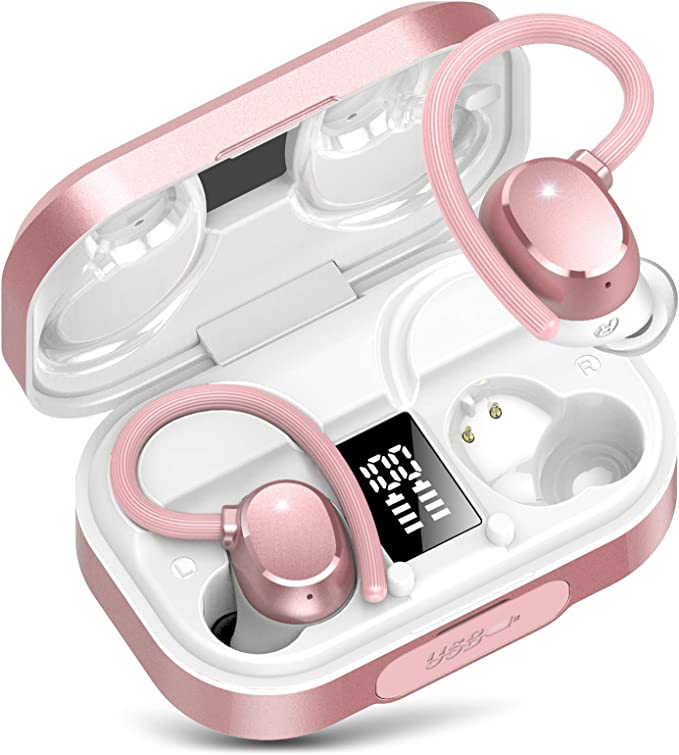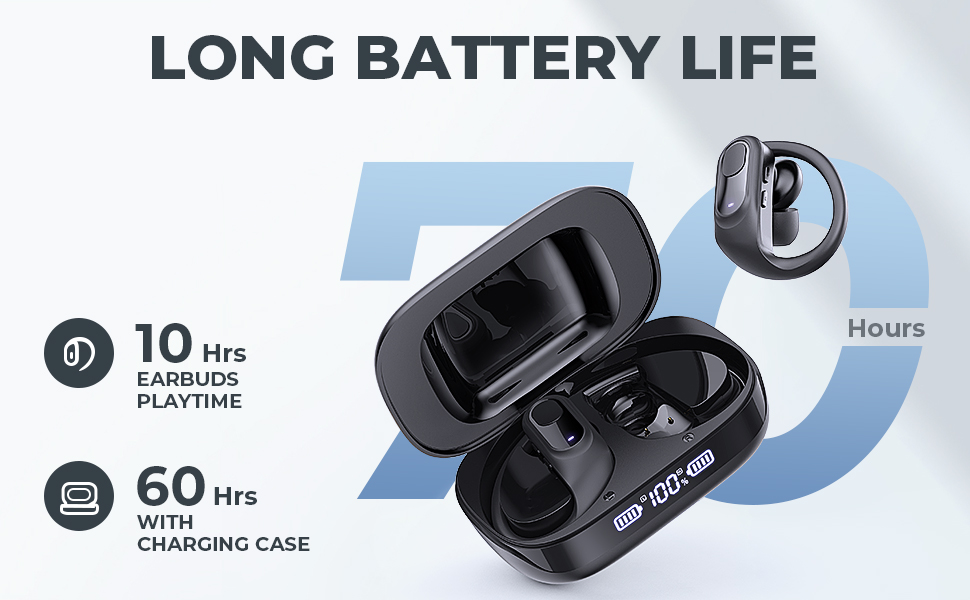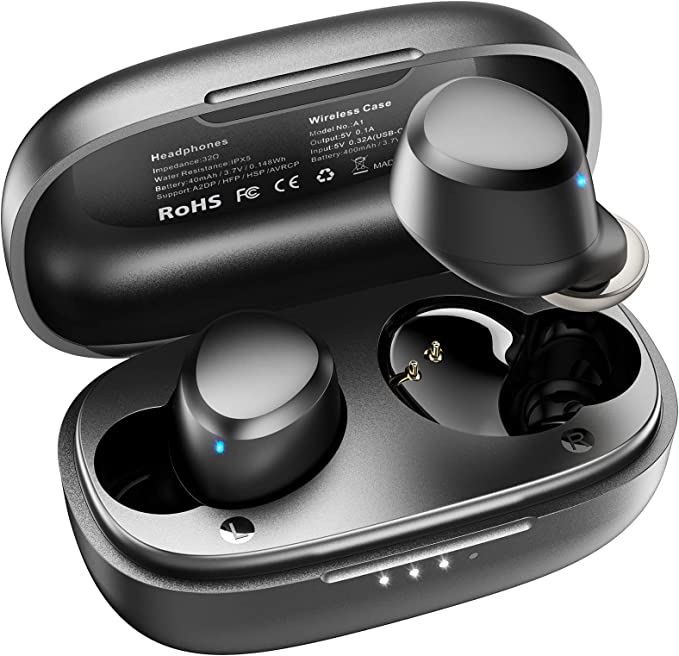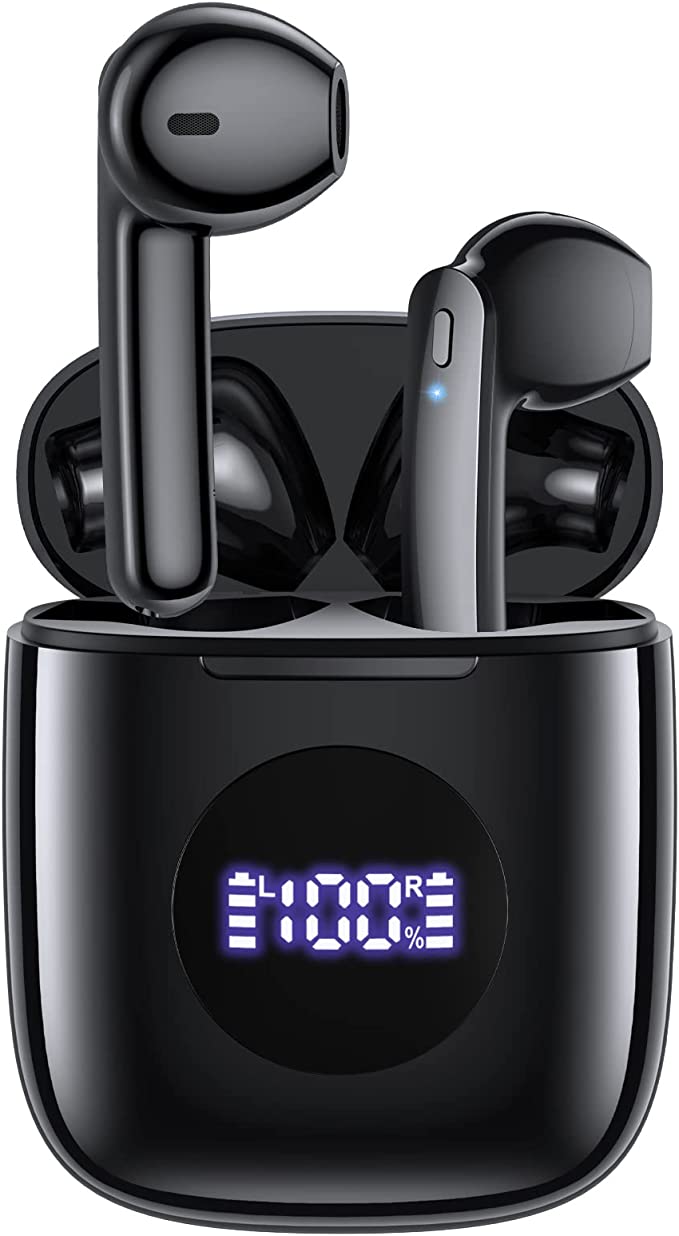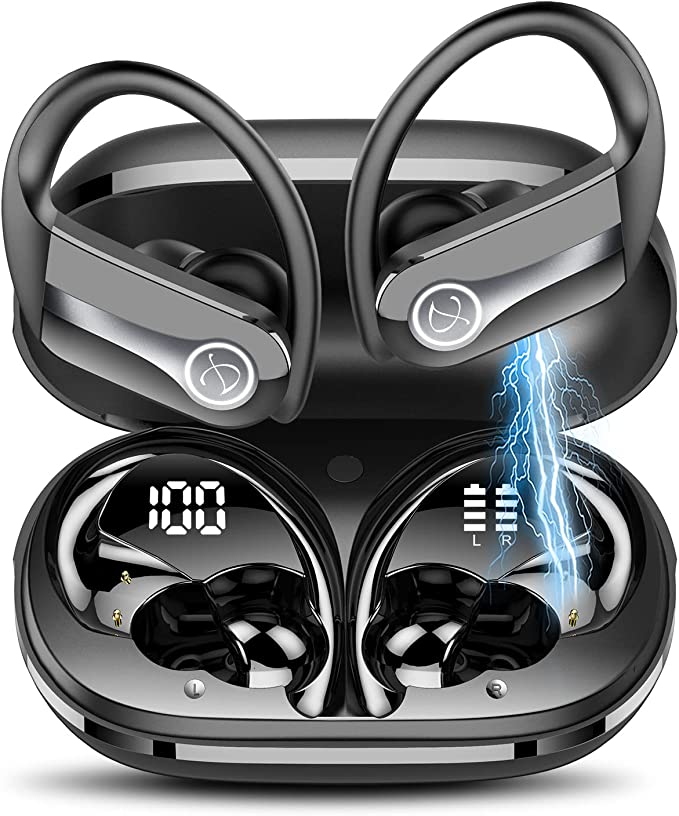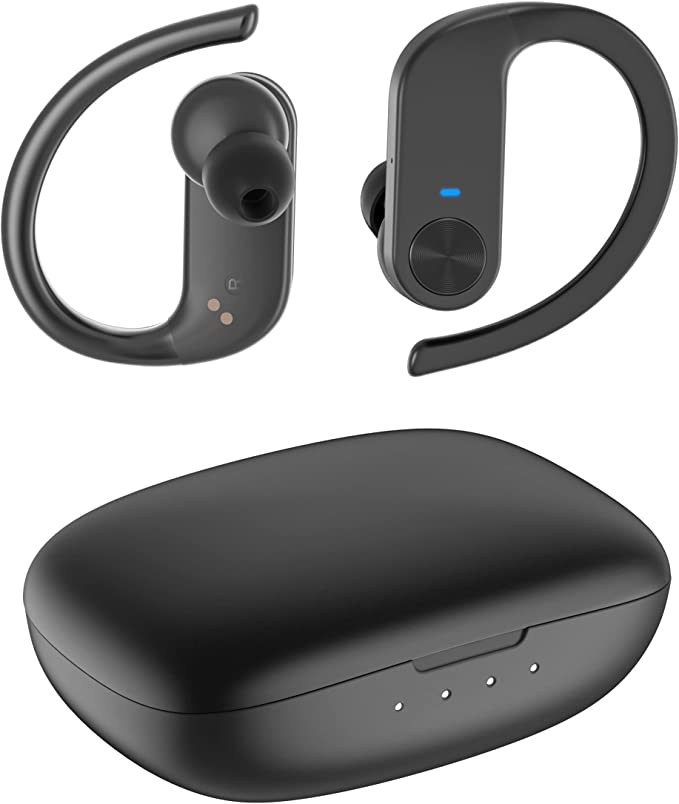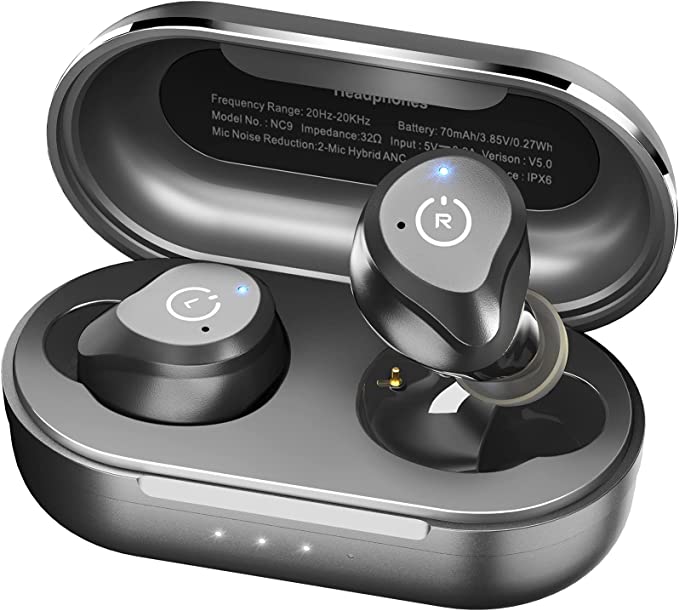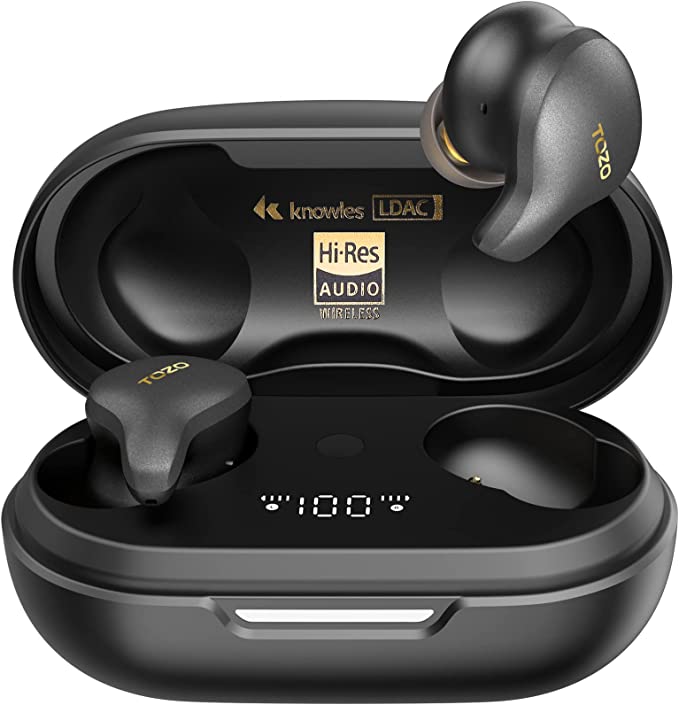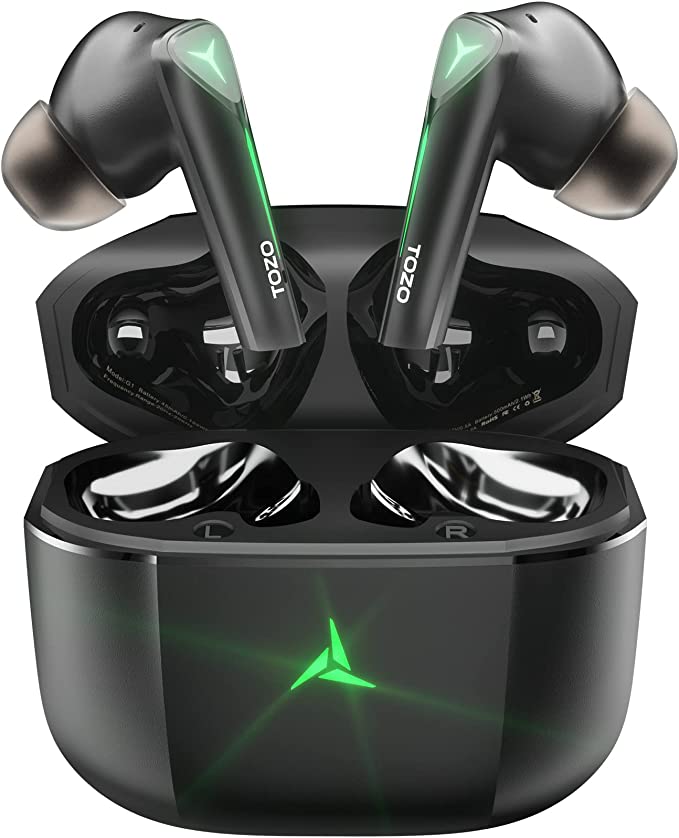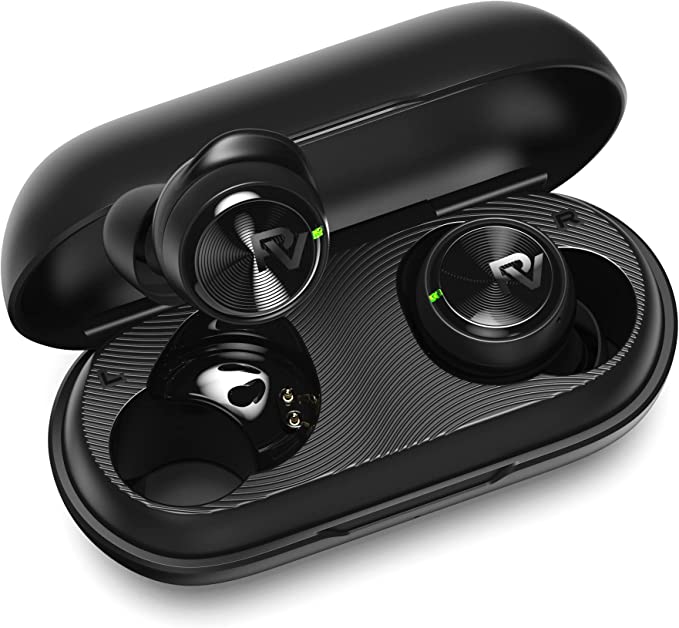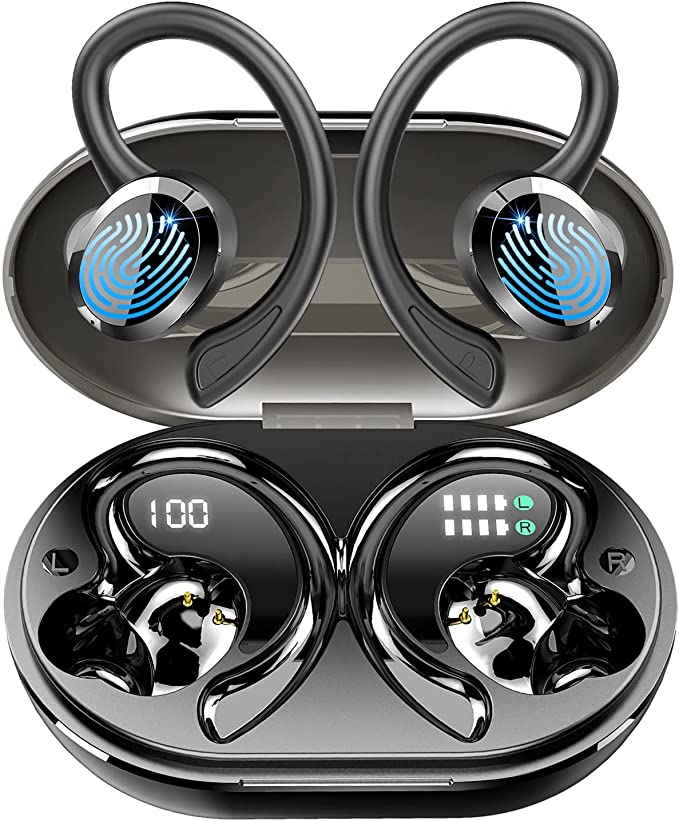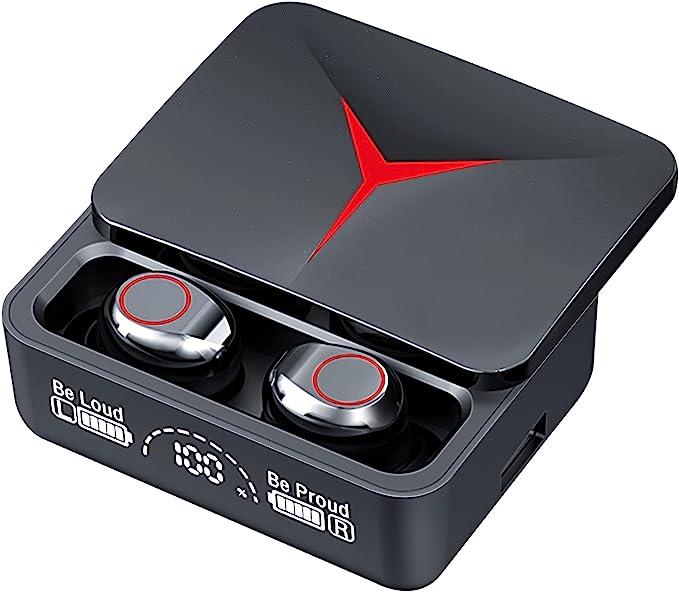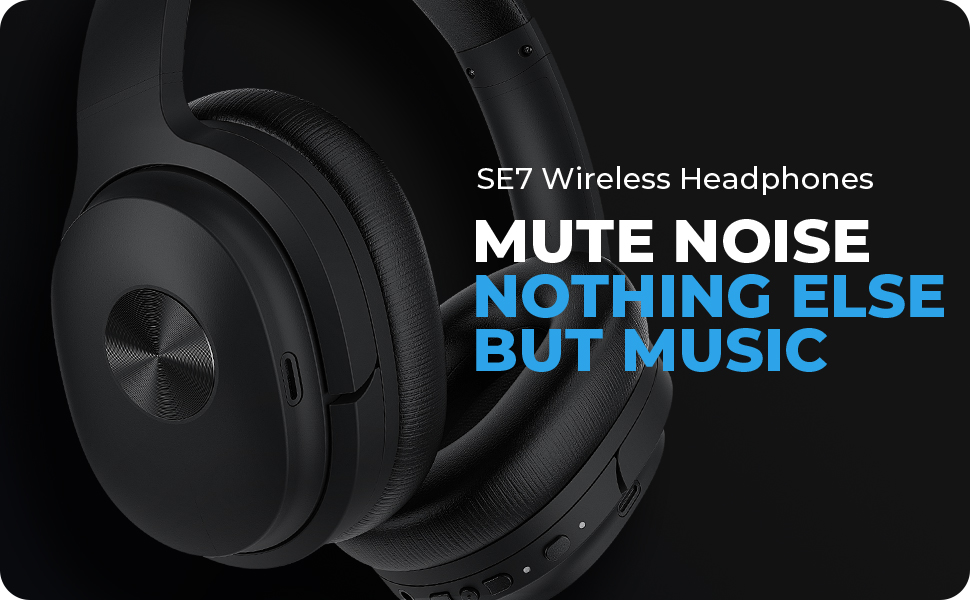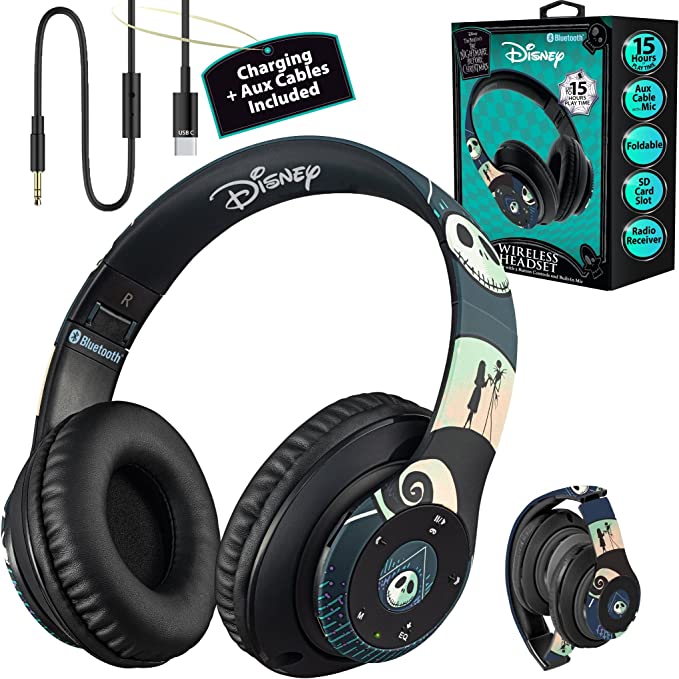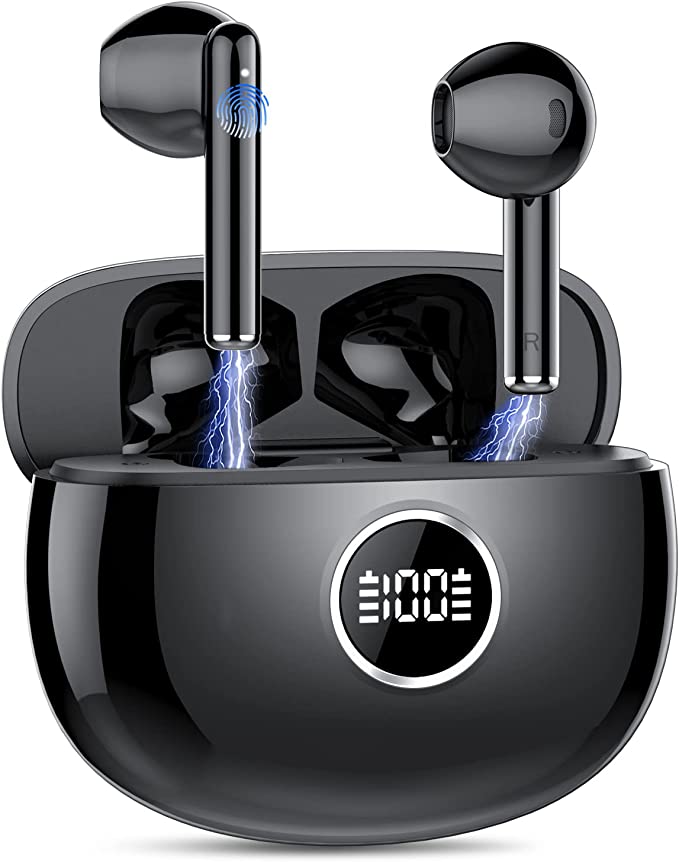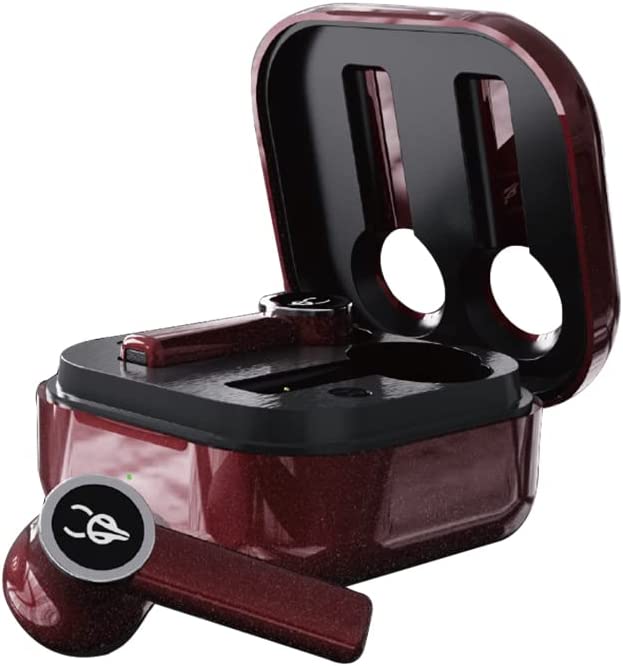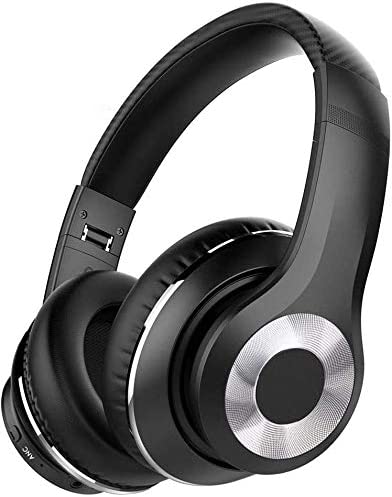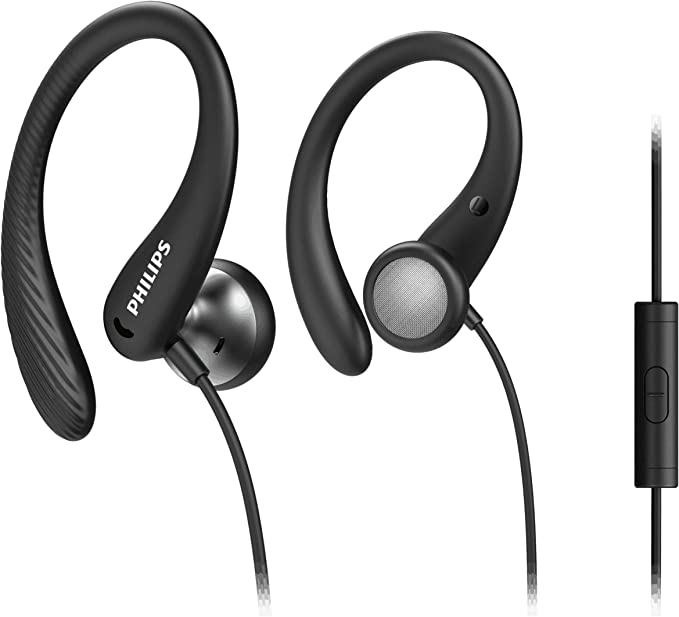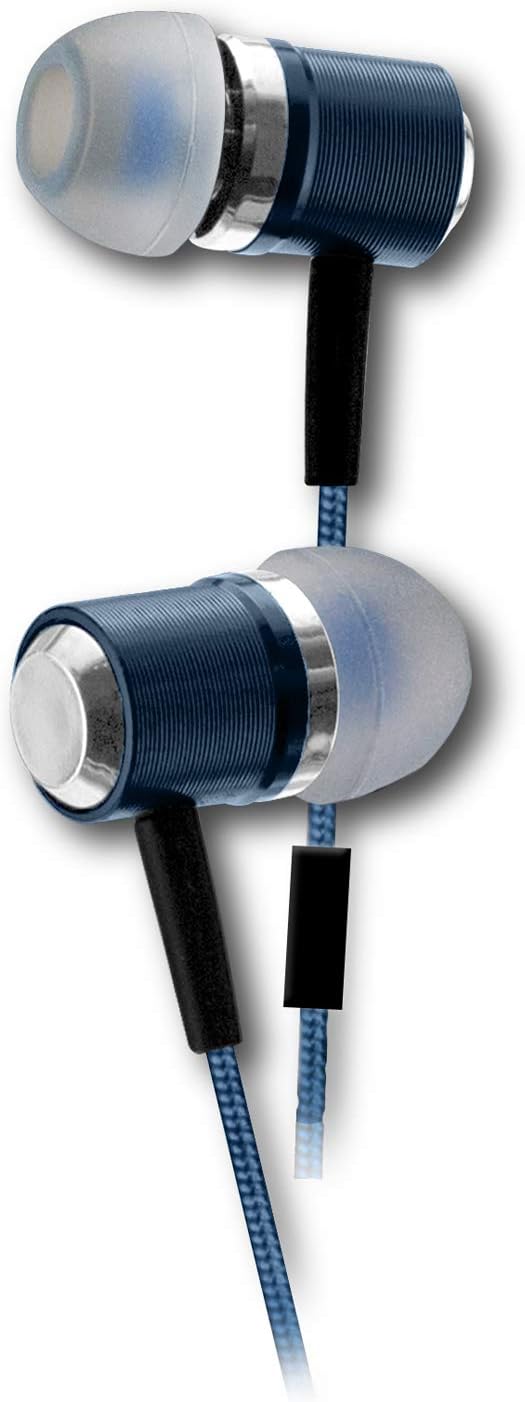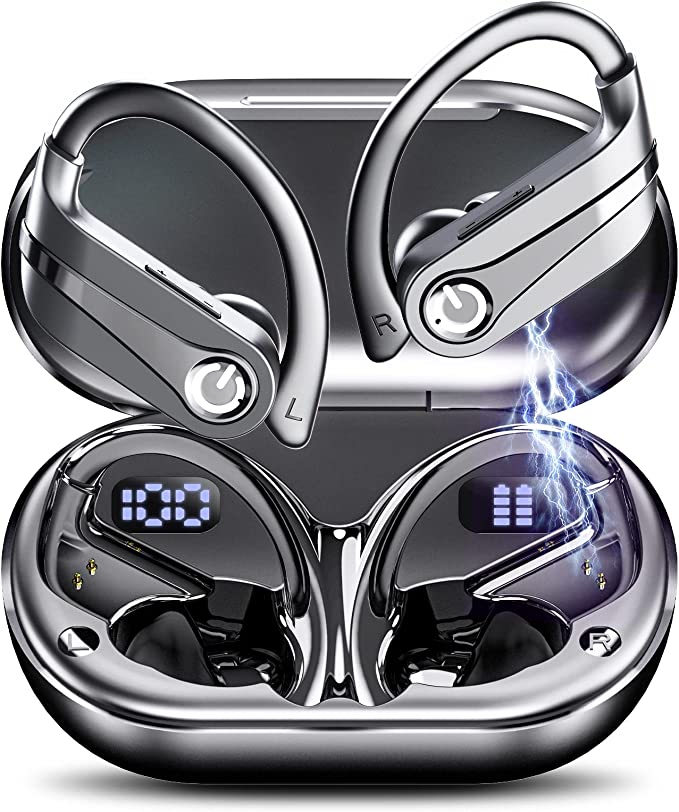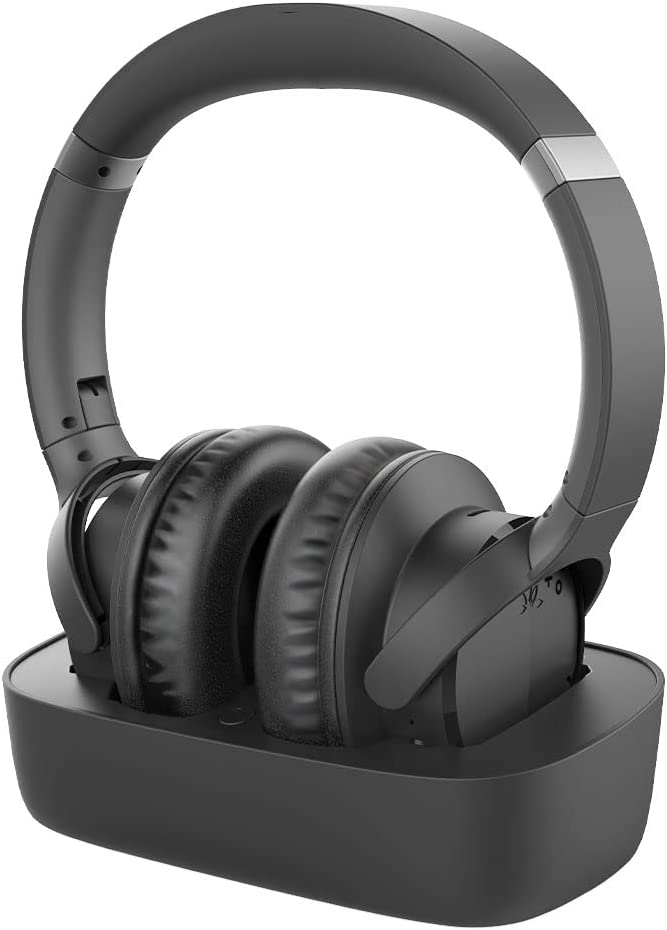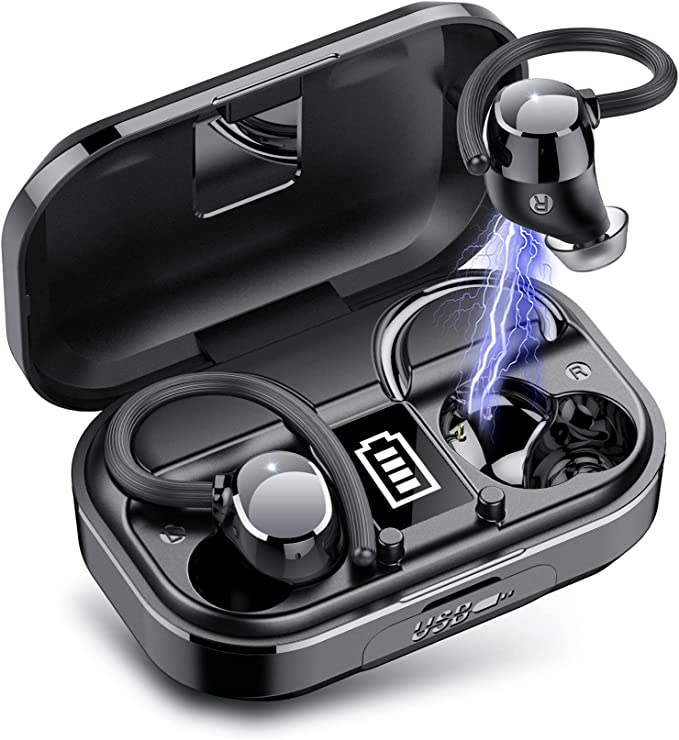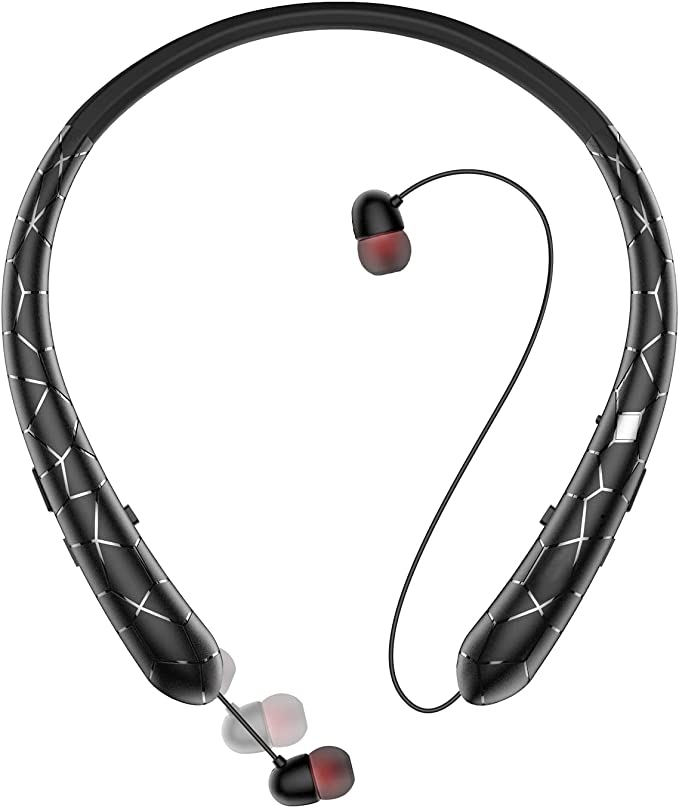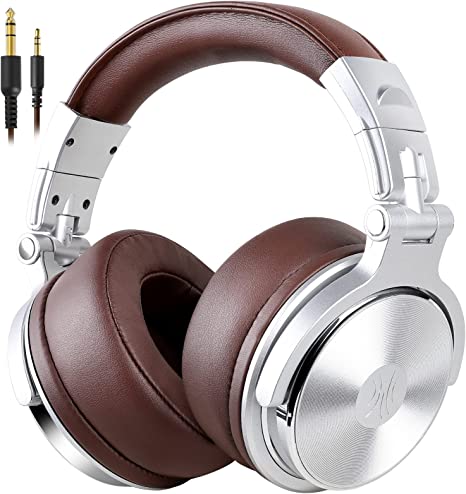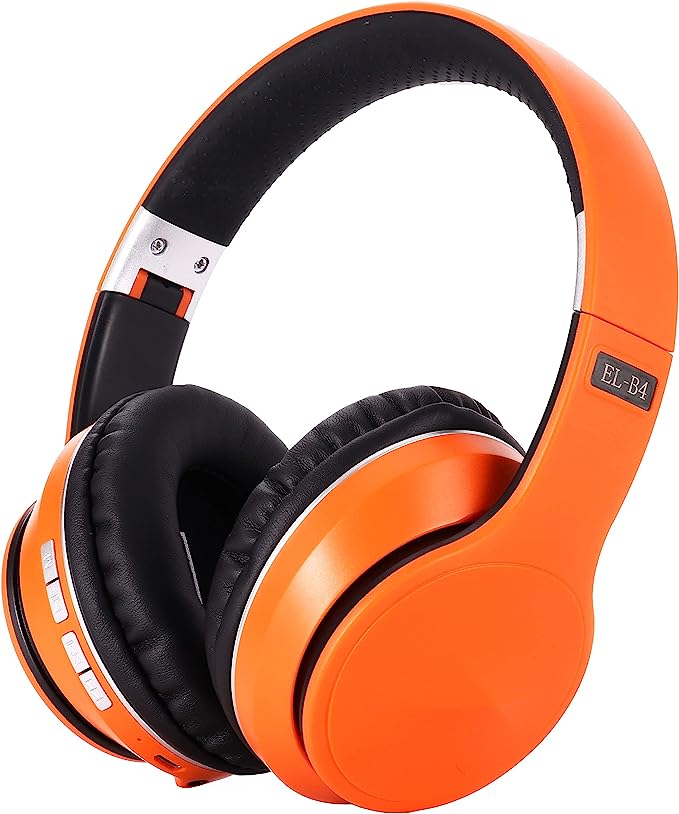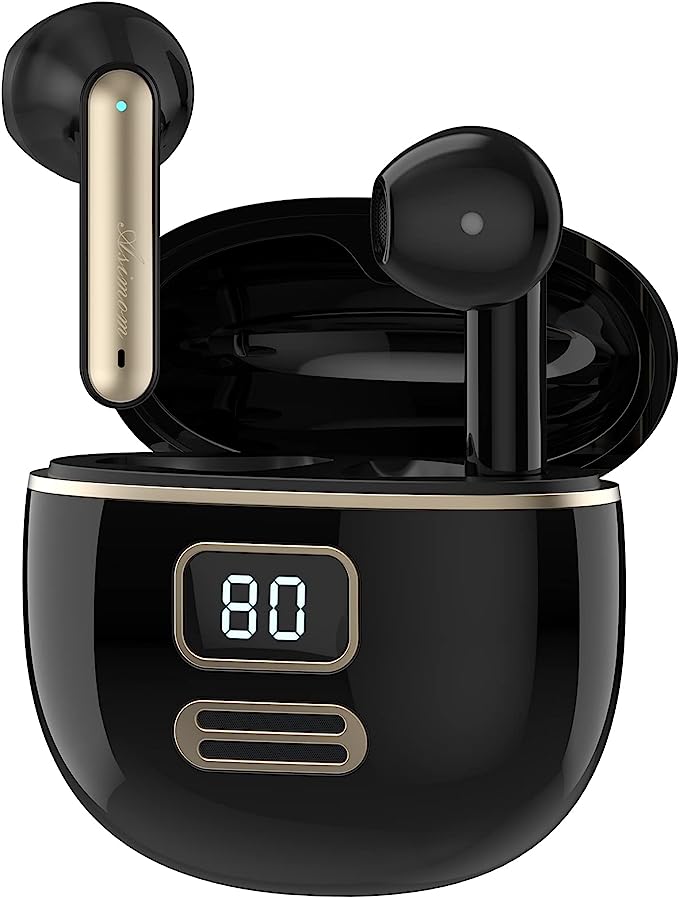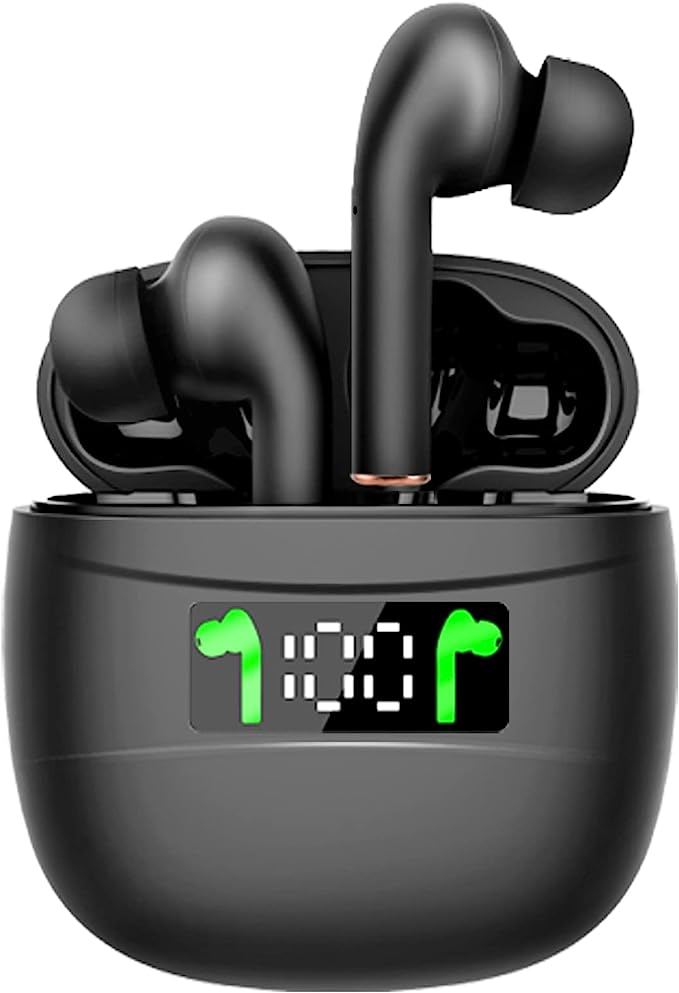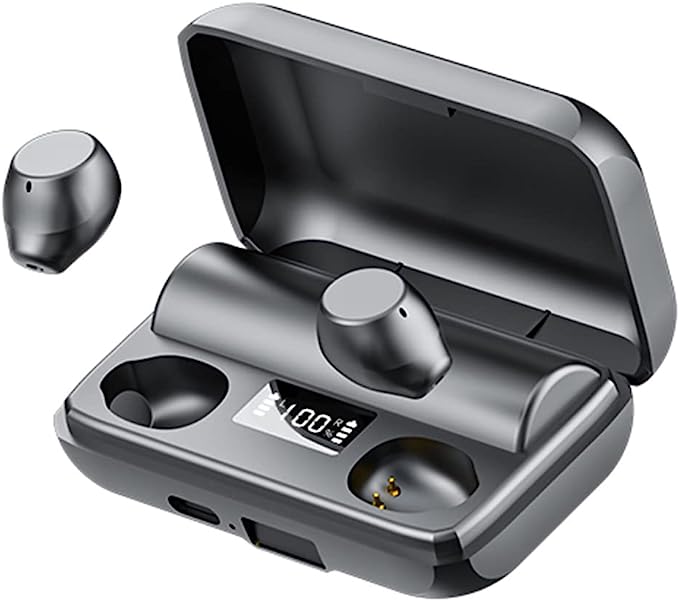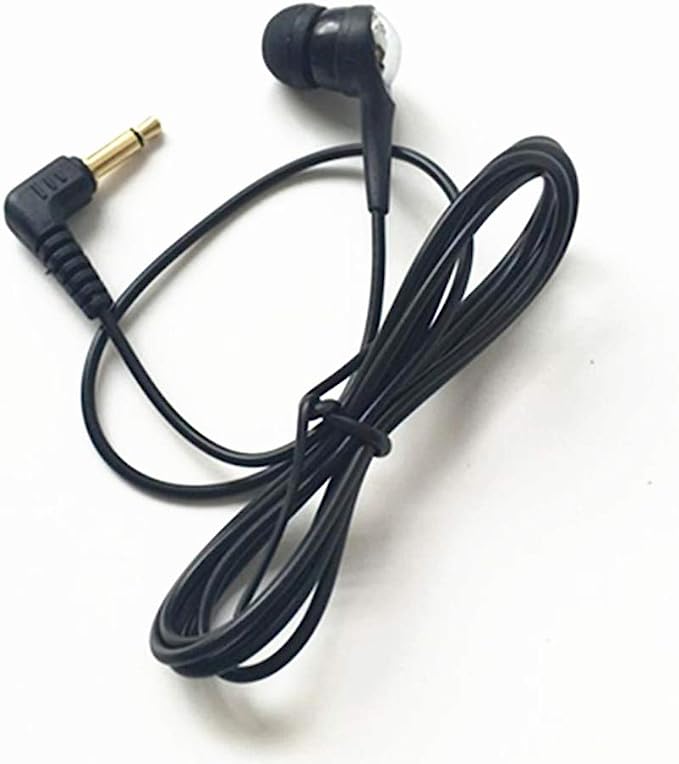EUQQ Q63-5RED Wireless Earbuds: Unveiling the Science Behind 120H Playtime, Bluetooth 5.3 Stability, and Workout-Ready Design
Update on May 19, 2025, 5:13 p.m.
In the vibrant, often chaotic soundscape of modern life, our personal audio devices have become more than mere accessories; they are intimate companions. They deliver the energizing playlists for our morning runs, the focused calm of a podcast during a bustling commute, and the vital connection to colleagues in a world increasingly reliant on remote collaboration. But this deep integration brings with it a fervent quest: a quest for true sonic freedom. We crave audio that is untethered, yet unwavering; powerful in its endurance, yet resilient against the rigors of our active lives. It’s a tall order, but one that engineers and scientists relentlessly pursue.
Consider, for a moment, a pair of wireless sports earbuds like the EUQQ Q63-5RED. While information from its original listing indicates it is “currently unavailable,” its described features – Bluetooth 5.3, an astounding 120-hour playtime, a sports-centric over-ear design with earhooks, waterproofing, and an LED power display – make it an excellent archetype, a fascinating lens through which we can explore the invisible marvels of everyday technology. These aren’t just bullet points on a retail page; they are culminations of decades of research in fields ranging from radio physics to material science and human ergonomics. So, let’s embark on a journey, not to review a product, but to unpack the symphony of science that allows such tiny devices to perform feats that would have seemed like science fiction just a generation ago. What hidden concert of engineering brilliance is being conducted right in, and on, our ears?

The Invisible Handshake: Demystifying Bluetooth 5.3’s Stable Embrace
At the very core of any wireless audio experience lies the magic of Bluetooth. It’s an invisible handshake, a silent conversation happening a hundred times a second between your earbuds and your phone, tablet, or laptop. The EUQQ Q63-5RED earbuds are listed with Bluetooth 5.3, a specific dialect in this ongoing technological dialogue. But to truly appreciate what “5.3” signifies, we need a brief journey back in time.
From Royal Origins to Radio Waves
The name “Bluetooth” itself is a curious nod to history, a tribute to Harald “Bluetooth” Gormsson, a 10th-century Danish king famed for uniting dissonant Danish tribes into a single kingdom. The engineers at Ericsson who initiated the technology in the 1990s envisioned their “short-link” radio technology similarly uniting different communication protocols and devices. What started as a cable-replacement project has blossomed into a global standard connecting billions of devices, from a fitness tracker syncing your steps to, of course, earbuds streaming your favorite symphony.
The journey from Bluetooth 1.0 to the 5.x series has been one of relentless refinement, driven by our ever-increasing demands for faster speeds, longer ranges, lower power consumption, and, crucially for audio, unwavering stability. Each iteration has built upon the last, tackling previous bottlenecks and opening new possibilities, especially with the rise of the Internet of Things (IoT) and the burgeoning world of wearable audio.

Decoding “5.3”: More Than Just a Number
So, what does the “.3” in Bluetooth 5.3, as featured in the EUQQ Q63-5RED’s specifications, bring to this invisible handshake? It’s not just an incremental update; it represents several subtle but significant enhancements designed to make the wireless experience smoother, more efficient, and more robust.
Think of Bluetooth 5.3 as a more intelligent and considerate conversationalist. Key improvements often associated with this standard include:
- Connection Subrating: Imagine you and a friend are having a long conversation (your phone and earbuds). If there are moments where less information needs to be exchanged, Connection Subrating allows the devices to quickly switch to a lower-energy “chat” mode without fully ending and restarting the intense “discussion” mode. This saves precious battery power and makes the connection feel more responsive when it needs to ramp up again. It’s like an intelligent energy-saving mode for that constant handshake.
- Periodic Advertising Enhancements: Bluetooth devices often “advertise” their presence or broadcast information. Version 5.3 allows for more efficiency in how this information is sent and received. If a device has already processed an advertisement, it can quickly ignore redundant subsequent transmissions, again saving processing power and energy.
- LE Audio Readiness & the LC3 Codec (General Concept): While specific LE Audio support in the EUQQ Q63-5RED is not detailed in the provided snippet, Bluetooth 5.2 and later versions pave the way for LE Audio. This is a game-changer, promising higher audio fidelity at significantly lower power consumption, thanks to a new codec called LC3 (Low Complexity Communications Codec). Think of LC3 as offering a “high-definition, low-calorie diet” for your audio streams. LE Audio also introduces exciting possibilities like Auracast™ broadcast audio, allowing a single source to stream to multiple listeners – imagine sharing your playlist silently with friends in a park or tuning into public announcements at an airport directly through your earbuds.
- Improved Channel Classification: The airwaves are crowded with Wi-Fi, microwaves, and other Bluetooth devices. Bluetooth 5.3 enhances the ability of devices to identify and avoid “noisy” channels, much like a smart traffic controller rerouting cars to avoid jams. This leads to fewer interferences and a more stable connection, which is paramount when you’re relying on uninterrupted audio for a crucial call or an immersive music session.
The science behind this involves an intricate dance of radio waves, typically in the 2.4 GHz spectrum (similar to Wi-Fi, but with different protocols). Tiny antennas within the earbuds send and receive data packets – small bundles of your audio information – to and from your source device. The sophistication of Bluetooth 5.3 lies in how intelligently it manages these packets, how efficiently it uses the radio spectrum, and how parsimoniously it sips battery power.

For Your Ears Only
For a user of earbuds like the EUQQ Q63-5RED, these under-the-hood improvements translate into very tangible benefits. It means a more steadfast connection as you weave through a crowded city street, your music or podcast flowing without frustrating skips. It means the earbuds’ own internal batteries last longer on a single charge, complementing the charging case’s capacity. It could also mean better synchronization between audio and video when you’re watching a movie on your tablet. Ultimately, Bluetooth 5.3 aims to make the technology so reliable and unobtrusive that you forget it’s even there, allowing you to simply immerse yourself in your sound.

The Marathon Runner’s Heart: Unpacking the Science of 120-Hour Playtime
There are few things more deflating in our hyper-connected, media-rich lives than the dreaded low-battery warning, especially when it silences the soundtrack to our activities. The EUQQ Q63-5RED’s listed specification of “120H Playtime” immediately catches the eye, sounding almost like a typographical error. How can such diminutive devices harbor the heart of a marathon runner? The answer lies in a potent synergy of advanced battery technology, hyper-efficient electronics, and the clever design of the charging case ecosystem.
The Tyranny of the Charging Cable (and the Dream of Escaping It)
For years, users of portable electronics have lived under the tyranny of the charging cable, constantly scouting for a free power outlet. This “battery anxiety” is a real phenomenon, a low-level hum of stress in our daily lives. The promise of ultra-long playtime, like the 120 hours mentioned for these EUQQ earbuds, speaks directly to our desire for liberation from this anxiety, offering a glimpse into a future where “charging amnesia” – forgetting the last time you even thought about charging – becomes the norm.
Inside the Powerhouse: A Peek into Modern Battery Tech
The unsung hero of this endurance saga is the lithium-ion battery. Its development, recognized with the Nobel Prize in Chemistry in 2019, revolutionized portable electronics. These batteries pack an incredible amount of energy into a very small and lightweight package – a property known as high energy density. Within the EUQQ Q63-5RED earbuds themselves, tiny lithium-ion cells provide the immediate power for your listening.
However, the “120H Playtime” almost certainly refers to the total listening time achievable with the included charging case. This case isn’t just a convenient storage box; it’s a portable power bank, housing a significantly larger lithium-ion battery of its own. Once the earbuds run low after several hours of continuous use, placing them back into their magnetically aligned slots in the case initiates a recharge. The case can typically recharge the earbuds multiple times before it, too, needs to be plugged in. It’s a clever two-stage system: the earbuds are the sprinters, and the case is their mobile pit stop and endurance coach, always ready to refuel them for the next leg of the race.

The Orchestra of Efficiency
But simply stuffing in a big battery isn’t the whole story. Achieving such remarkable playtime figures also requires a meticulously orchestrated effort in power efficiency across the entire device:
- Bluetooth Low Energy (BLE): As we explored earlier, standards like Bluetooth 5.3 are designed with power frugality in mind. The LE aspects ensure that the constant wireless communication sips, rather than gulps, energy.
- Power Management Integrated Circuits (PMICs): These are specialized chips, the true unsung heroes within both the earbuds and the charging case. PMICs are like microscopic accountants, meticulously managing every milliwatt of power. They regulate voltage, optimize charging cycles to prolong battery health, and ensure that no energy is wasted by components that aren’t actively in use. Their sophistication is a key reason why modern devices can do so much more with so much less power.
- Efficient Audio Codecs & Amplifiers: While not detailed for the Q63-5RED, the chips responsible for decoding the audio signal (codecs) and amplifying it to drive the tiny speakers also play a role. Modern designs strive for high fidelity with minimal power draw.
Living with 120 Hours (as claimed for EUQQ Q63-5RED)
Imagine the freedom this kind of endurance offers. For an athlete, it could mean weeks of workouts without plugging in. For a traveler, it’s an entire long-haul flight, plus days of sightseeing, all on a single case charge. For the busy professional, it’s countless calls and focus sessions without interruption.
Adding to this convenience is the LED Power Display, another feature listed for the EUQQ Q63-5RED. This seemingly simple addition is a practical piece of user-centered design. Typically, a series of LEDs or a small digital percentage readout will indicate the remaining charge in the case, and sometimes even the charge status of each earbud. This “fuel gauge for your sound” eliminates the guesswork, allowing you to plan recharges proactively and never be caught out with a dead battery at an inopportune moment. It’s a small touch, but one that significantly enhances the user experience by providing clear, immediate feedback.
Beyond the Hours: The Quest for Sustainable Power
While celebrating such long playtimes, it’s also worth a brief, broader thought: the relentless pursuit of power efficiency and longer battery lifecycles in consumer electronics is not just about convenience. It also subtly aligns with a growing awareness of sustainability. More efficient devices consume less energy overall, and batteries that last longer (both per charge and in total lifespan) contribute, albeit modestly, to reducing e-waste. This larger context adds another layer to appreciating the engineering behind a feature like 120-hour playtime.

Forged for Movement, Shielded from Elements: The Engineering of Sports Earbuds
The demands placed on sports earbuds go far beyond just sounding good or lasting long. They must become almost an extension of the athlete’s body: secure enough to withstand the most vigorous movements, comfortable enough for hours of wear, and resilient enough to shrug off sweat and the occasional unexpected rain shower. The EUQQ Q63-5RED’s listed features – an “Over-Ear” form factor with “Earhooks” and a “Waterproof” designation – point directly to this specialized branch of audio engineering, where ergonomics, material science, and an understanding of biomechanics play leading roles.
The Dance of Physics: Why Earbuds Fall Out (and How to Stop Them)
Anyone who has ever tried to run with ill-fitting earbuds knows the frustration. Gravity, the constant jarring impacts of each footfall, the inertia from quick head turns – all conspire to dislodge a poorly secured earbud, often at the most inconvenient moment. This is where thoughtful ergonomic design, like the over-ear style and earhooks mentioned for the EUQQ Q63-5RED, comes into play.
- The Ergonomic Answer: “Ergonomics” is the science of designing products to fit the human body optimally, enhancing efficiency and comfort while minimizing discomfort or risk of injury. For earbuds, this is paramount.
- Over-Ear Design with Earhooks: This style explicitly addresses stability. The earhook, typically a flexible yet firm extension, loops over the top and behind the auricle (the visible part of the ear). This creates multiple points of contact, distributing the earbud’s minimal weight and providing crucial leverage against the forces trying to pull it out. It’s like adding an extra anchor point. The “over-ear” aspect often implies that a portion of the earbud body might also rest on the concha of the ear, further aiding stability.
- Science of Secure Fit: The goal is to achieve a delicate balance: a fit snug enough to stay put and seal out some external noise (passive noise isolation), but not so tight as to cause pressure points or discomfort over time. Engineers consider the average anatomy of the human ear, but also often include various sizes of ear tips (usually silicone or foam) to allow for a more customized fit. The material of the earhook itself is also important – it needs to be soft enough for comfort against the skin, yet resilient enough to maintain its shape and grip. This is a direct application of biomechanics, understanding how the ear moves and interacts with a foreign object during dynamic activity.
The evolution of headphone design from bulky, head-clamping contraptions of the past to these sleek, secure sports-focused earbuds is a testament to advancements in miniaturization and a deeper understanding of human factors.
Braving the Storm (or Just a Good Sweat): The “Waterproof” Promise
Exercise means sweat, and sometimes it means an unexpected downpour. Moisture is the natural enemy of delicate electronics. Thus, a “Waterproof” claim, as listed for the EUQQ Q63-5RED, is a vital feature for any true sports earbud.
- What “Waterproof” Typically Means: While the specific Ingress Protection (IP) rating for the EUQQ Q63-5RED isn’t provided in the available snippet, this term in the context of sports electronics usually implies a significant level of resistance to moisture.
- Demystifying IP Ratings: The IP Code is an international standard (IEC 60529) that classifies the degrees of protection provided by enclosures of electrical equipment. It’s usually written as “IPXY,” where X indicates protection against solid particles (dust) and Y indicates protection against liquids.
- For sports earbuds, you’ll often see ratings like IPX4 (protects against splashing water from any direction – good for sweat and light rain), IPX5 (protects against water jets), IPX6 (strong water jets), or even IPX7 (protects against temporary immersion in water up to 1 meter for 30 minutes). Without a specific rating, “waterproof” for the EUQQ Q63-5RED implies it’s designed to handle the typical moisture encountered during workouts. Users looking for robust water protection should always seek out a specific IP rating from the manufacturer.
- The Engineering of Resilience: Achieving water resistance involves several strategies:
- Sealed Casings: The outer shells of the earbuds are designed with tight tolerances. Seams and joints are often sealed with rubber gaskets or specialized adhesives to prevent water ingress.
- Protective Membranes: Microphone openings and speaker ports, which are necessary for function, are often covered with acoustic membranes that allow sound to pass but repel water molecules.
- Hydrophobic Nano-Coatings: Sometimes, internal components or the entire circuit board are treated with an ultra-thin, invisible nano-coating. This coating is highly water-repellent (hydrophobic), causing moisture to bead up and roll off rather than seeping in and causing shorts or corrosion.
The Athlete’s Ally:
These design choices – the secure embrace of earhooks and the shielding offered by waterproofing – are what transform a simple pair of earbuds into a reliable ally for the athlete. They provide the confidence to push personal limits, to focus on the rhythm of breath and movement, rather than on fumbling with a dislodged earbud or worrying about sweat damage. For anyone leading an active lifestyle, this fusion of ergonomic science and material resilience in products like the EUQQ Q63-5RED is not just a convenience; it’s an enabler.
Harmony of Parts: When Technology Sings in Unison
Having journeyed through the intricacies of Bluetooth 5.3, the marvel of 120-hour playtime, and the thoughtful engineering behind secure, water-resistant designs, it becomes clear that the EUQQ Q63-5RED, like any well-designed piece of technology, is more than the sum of its parts. These features are not isolated islands of innovation; they are a carefully orchestrated ensemble, working in concert to deliver a cohesive and purposeful user experience.
Imagine the seamless flow: the Bluetooth 5.3 connection establishes that “invisible handshake” with your device, ensuring your motivational playlist or crucial podcast streams with unwavering stability, even as you move with vigor. This stable connection is maintained with remarkable energy efficiency, which, in turn, contributes to the epic 120-hour playtime (factoring in the charging case). This endurance means you’re seldom tethered to a charger, free to integrate sound into your life for days, even weeks, on end. The LED power display acts as a transparent communicator, keeping you informed of your energy reserves, banishing battery anxiety.
Then, as you embark on your workout, the over-ear design with earhooks comes into its own, anchoring the earbuds securely, transforming them into a natural extension of your body. You can sprint, jump, and push your limits, confident that your audio companion will stay put. And should that workout be particularly intense, or if the weather turns, the “inalambricos” (wireless) nature combined with the waterproof construction provides a shield, protecting the delicate electronics within from the corrosive effects of sweat or the inconvenience of rain.
The term “Audifonos Bluetooth inalambricos,” as it appears in the product’s full name, speaks to a universal appeal – the desire for wireless audio freedom. But the additional sports-focused features indicate that the EUQQ Q63-5RED was envisioned for a user who is not just passively listening, but actively engaging with the world, demanding more from their technology in terms of stability, endurance, and resilience. It’s this targeted engineering, this understanding of a specific user’s needs and pain points, that allows the individual technological elements to sing in unison, creating an experience that feels intuitive and empowering. The true magic lies not just in each brilliant component, but in their harmonious interplay, conducted by the needs and aspirations of the user.

Coda: The Ever-Evolving Soundtrack of Our Lives
Our exploration of the technologies underpinning a device like the EUQQ Q63-5RED takes us on a fascinating journey – from the regal history embedded in Bluetooth’s name to the cutting-edge science of lithium-ion batteries and the meticulous art of ergonomic design. It’s a vivid reminder that the sleek, seemingly simple gadgets we use every day are, in fact, repositories of immense human ingenuity, the culmination of countless hours of research, development, and refinement.
The evolution from cumbersome wired headphones to these intelligent, featherlight audio companions that can accompany us through marathons and rainstorms is nothing short of remarkable. And with each iteration, like the move towards Bluetooth 5.3, the promise of an even more seamless, more enduring, and more intuitive audio experience inches closer to reality.
To understand a little of the science in our pockets and on our ears is to be empowered. It allows us to appreciate not just what our devices do, but how they do it, fostering a deeper connection with the technology that shapes so much of our daily auditory world. It transforms us from passive consumers into informed admirers of the intricate engineering that crafts the soundtrack of our lives.
And the symphony is far from over. The quest for even better power efficiency, for more intelligent and context-aware audio features, for deeper and more seamless integration with our digital and physical environments, continues unabated. What might the next generation of wireless audio hold? Perhaps experiences so immersive and intuitive they feel less like using a device and more like an enhancement of our own senses.
As we unplug – or rather, as we embrace the sophisticated wireless connections that now define our audio world – let’s carry with us a sense of wonder for the unseen efforts and the brilliant science that make it all possible. The EUQQ Q63-5RED, even as a snapshot of technology at a particular point, serves as a compelling testament to this ongoing human endeavor: to innovate, to connect, and to enrich our lives, one perfectly delivered sound wave at a time.
